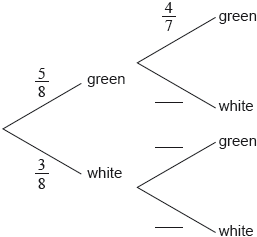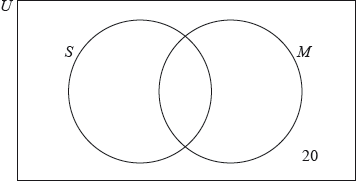| Date | November 2021 | Marks available | 1 | Reference code | 21N.2.SL.TZ0.1 |
| Level | Standard Level | Paper | Paper 2 | Time zone | Time zone 0 |
| Command term | Write down | Question number | 1 | Adapted from | N/A |
Question
A group of students were asked which electronic device they preferred. The results per age group are given in the following table.
A student from the group is chosen at random. Calculate the probability that the student
A test for independence was performed on the collected data at the significance level. The critical value for the test is .
prefers a tablet.
is years old and prefers a mobile phone.
prefers a laptop given that they are years old.
prefers a tablet or is years old.
State the null and alternative hypotheses.
Write down the number of degrees of freedom.
Write down the test statistic.
Write down the -value.
State the conclusion for the test in context. Give a reason for your answer.
Markscheme
A1A1
Note: Award A1 for correct numerator, A1 for correct denominator.
[2 marks]
A1A1
Note: Award A1 for correct numerator, A1 for correct denominator.
[2 marks]
A1A1
Note: Award A1 for correct numerator, A1 for correct denominator.
[2 marks]
OR (M1)
A1A1
Note: Award A1 for correct denominator seen, (M1) for correct calculation of the numerator, A1 for the correct answer.
[3 marks]
the variables are independent
the variables are dependent A1
Note: Award A1 for for both hypotheses correct. Do not accept “not correlated” or “not related” in place of “independent”.
[1 mark]
A1
[1 mark]
A2
[2 marks]
OR A1
[1 mark]
EITHER
R1
OR
R1
THEN
(there is sufficient evidence to accept that) preferred device and age group are not independent A1
Note: For the final A1 the answer must be in context. Do not award A1R0.
[2 marks]
Examiners report
A common error was to treat these as compound probability events. Candidates who attempted to use the conditional probability formula in part (a)(iii) often accrued at least one mark for a correct method. Some lost one mark for not reducing the total sample space. In part (a)(iv) many found , failing to subtract the intersection of the two events. When stating test hypotheses, terminology such as "related", "correlated", "data is independent" are not acceptable. Few candidates attempted to frame this as a Goodness of Fit test. Candidates correctly wrote down the degrees of freedom. It was pleasing to see most found the correct -test statistic and associated p-value. Relative to past examination sessions, fewer candidates appeared to compare the critical value with the p-value or the -test statistic with the level of significance. A conclusion consistent with their hypotheses was usually seen, though this was not always expressed in context.
A common error was to treat these as compound probability events. Candidates who attempted to use the conditional probability formula in part (a)(iii) often accrued at least one mark for a correct method. Some lost one mark for not reducing the total sample space. In part (a)(iv) many found , failing to subtract the intersection of the two events. When stating test hypotheses, terminology such as "related", "correlated", "data is independent" are not acceptable. Few candidates attempted to frame this as a Goodness of Fit test. Candidates correctly wrote down the degrees of freedom. It was pleasing to see most found the correct -test statistic and associated p-value. Relative to past examination sessions, fewer candidates appeared to compare the critical value with the p-value or the -test statistic with the level of significance. A conclusion consistent with their hypotheses was usually seen, though this was not always expressed in context.
A common error was to treat these as compound probability events. Candidates who attempted to use the conditional probability formula in part (a)(iii) often accrued at least one mark for a correct method. Some lost one mark for not reducing the total sample space. In part (a)(iv) many found , failing to subtract the intersection of the two events. When stating test hypotheses, terminology such as "related", "correlated", "data is independent" are not acceptable. Few candidates attempted to frame this as a Goodness of Fit test. Candidates correctly wrote down the degrees of freedom. It was pleasing to see most found the correct -test statistic and associated p-value. Relative to past examination sessions, fewer candidates appeared to compare the critical value with the p-value or the -test statistic with the level of significance. A conclusion consistent with their hypotheses was usually seen, though this was not always expressed in context.
A common error was to treat these as compound probability events. Candidates who attempted to use the conditional probability formula in part (a)(iii) often accrued at least one mark for a correct method. Some lost one mark for not reducing the total sample space. In part (a)(iv) many found , failing to subtract the intersection of the two events. When stating test hypotheses, terminology such as "related", "correlated", "data is independent" are not acceptable. Few candidates attempted to frame this as a Goodness of Fit test. Candidates correctly wrote down the degrees of freedom. It was pleasing to see most found the correct -test statistic and associated p-value. Relative to past examination sessions, fewer candidates appeared to compare the critical value with the p-value or the -test statistic with the level of significance. A conclusion consistent with their hypotheses was usually seen, though this was not always expressed in context.
A common error was to treat these as compound probability events. Candidates who attempted to use the conditional probability formula in part (a)(iii) often accrued at least one mark for a correct method. Some lost one mark for not reducing the total sample space. In part (a)(iv) many found , failing to subtract the intersection of the two events. When stating test hypotheses, terminology such as "related", "correlated", "data is independent" are not acceptable. Few candidates attempted to frame this as a Goodness of Fit test. Candidates correctly wrote down the degrees of freedom. It was pleasing to see most found the correct -test statistic and associated p-value. Relative to past examination sessions, fewer candidates appeared to compare the critical value with the p-value or the -test statistic with the level of significance. A conclusion consistent with their hypotheses was usually seen, though this was not always expressed in context.
A common error was to treat these as compound probability events. Candidates who attempted to use the conditional probability formula in part (a)(iii) often accrued at least one mark for a correct method. Some lost one mark for not reducing the total sample space. In part (a)(iv) many found , failing to subtract the intersection of the two events. When stating test hypotheses, terminology such as "related", "correlated", "data is independent" are not acceptable. Few candidates attempted to frame this as a Goodness of Fit test. Candidates correctly wrote down the degrees of freedom. It was pleasing to see most found the correct -test statistic and associated p-value. Relative to past examination sessions, fewer candidates appeared to compare the critical value with the p-value or the -test statistic with the level of significance. A conclusion consistent with their hypotheses was usually seen, though this was not always expressed in context.
A common error was to treat these as compound probability events. Candidates who attempted to use the conditional probability formula in part (a)(iii) often accrued at least one mark for a correct method. Some lost one mark for not reducing the total sample space. In part (a)(iv) many found , failing to subtract the intersection of the two events. When stating test hypotheses, terminology such as "related", "correlated", "data is independent" are not acceptable. Few candidates attempted to frame this as a Goodness of Fit test. Candidates correctly wrote down the degrees of freedom. It was pleasing to see most found the correct -test statistic and associated p-value. Relative to past examination sessions, fewer candidates appeared to compare the critical value with the p-value or the -test statistic with the level of significance. A conclusion consistent with their hypotheses was usually seen, though this was not always expressed in context.
A common error was to treat these as compound probability events. Candidates who attempted to use the conditional probability formula in part (a)(iii) often accrued at least one mark for a correct method. Some lost one mark for not reducing the total sample space. In part (a)(iv) many found , failing to subtract the intersection of the two events. When stating test hypotheses, terminology such as "related", "correlated", "data is independent" are not acceptable. Few candidates attempted to frame this as a Goodness of Fit test. Candidates correctly wrote down the degrees of freedom. It was pleasing to see most found the correct -test statistic and associated p-value. Relative to past examination sessions, fewer candidates appeared to compare the critical value with the p-value or the -test statistic with the level of significance. A conclusion consistent with their hypotheses was usually seen, though this was not always expressed in context.
A common error was to treat these as compound probability events. Candidates who attempted to use the conditional probability formula in part (a)(iii) often accrued at least one mark for a correct method. Some lost one mark for not reducing the total sample space. In part (a)(iv) many found , failing to subtract the intersection of the two events. When stating test hypotheses, terminology such as "related", "correlated", "data is independent" are not acceptable. Few candidates attempted to frame this as a Goodness of Fit test. Candidates correctly wrote down the degrees of freedom. It was pleasing to see most found the correct -test statistic and associated p-value. Relative to past examination sessions, fewer candidates appeared to compare the critical value with the p-value or the -test statistic with the level of significance. A conclusion consistent with their hypotheses was usually seen, though this was not always expressed in context.




